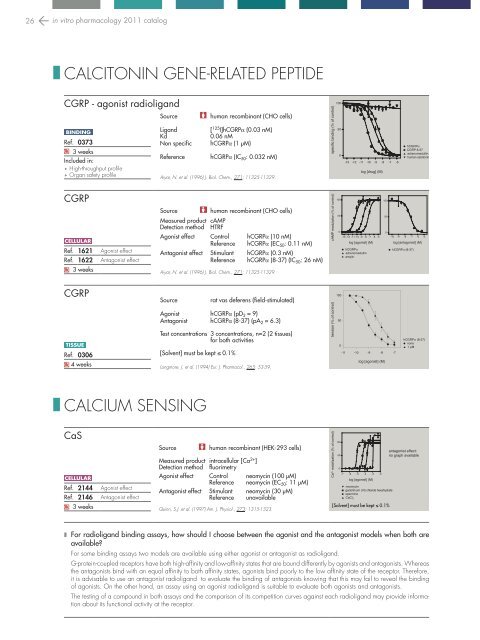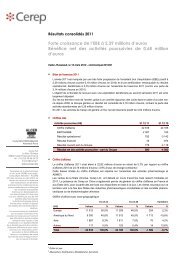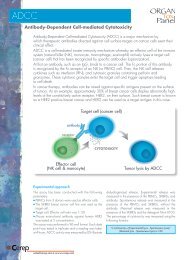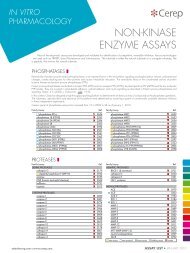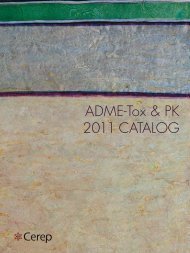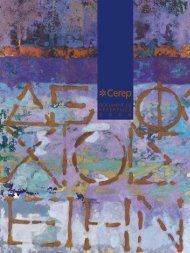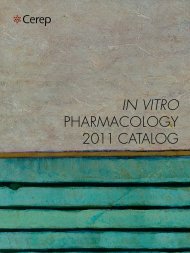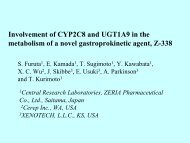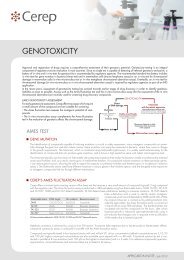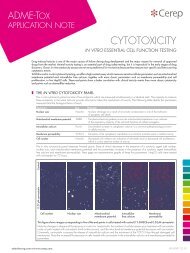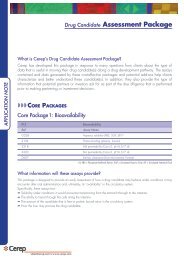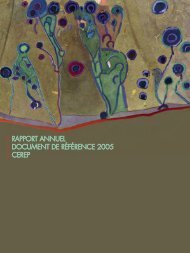in vitro PHARMACOLOGY 2011 CATALOG - Cerep
in vitro PHARMACOLOGY 2011 CATALOG - Cerep
in vitro PHARMACOLOGY 2011 CATALOG - Cerep
You also want an ePaper? Increase the reach of your titles
YUMPU automatically turns print PDFs into web optimized ePapers that Google loves.
26 <strong>in</strong> <strong>vitro</strong> pharmacology <strong>2011</strong> catalog<br />
❚ calciton<strong>in</strong> gene-related peptide<br />
CGRP - agonist radioligand<br />
b<strong>in</strong>d<strong>in</strong>g<br />
Ref. 0373<br />
Q 3 weeks<br />
Included <strong>in</strong>:<br />
High-throughput profile<br />
Organ safety profile<br />
Source<br />
Ligand<br />
Kd<br />
Non specific<br />
Reference<br />
human recomb<strong>in</strong>ant (CHO cells)<br />
[ 125 I]hCGRPa (0.03 nM)<br />
0.06 nM<br />
hCGRPa (1 µM)<br />
hCGRPa (IC 50 : 0.032 nM)<br />
Aiyar, N. et al. (1996) J. Biol. Chem., 271: 11325-11329.<br />
specific b<strong>in</strong>d<strong>in</strong>g (% of control)<br />
100<br />
50<br />
0<br />
-13 - 12 -11 - 10 -9 -8 -7 -6<br />
log [drug] (M)<br />
hCGRPα<br />
CGRP 8-37<br />
adrenomedull<strong>in</strong><br />
human calciton<strong>in</strong><br />
CGRP<br />
cellul ar<br />
Ref. 1621<br />
Ref. 1622<br />
Q 3 weeks<br />
Agonist effect<br />
Antagonist effect<br />
Source<br />
human recomb<strong>in</strong>ant (CHO cells)<br />
Measured product cAMP<br />
Detection method HTRF<br />
Agonist effect Control hCGRPa (10 nM)<br />
Reference hCGRPa (EC 50 : 0.11 nM)<br />
Antagonist effect Stimulant hCGRPa (0.3 nM)<br />
Reference hCGRPa (8-37) (IC 50 : 26 nM)<br />
Aiyar, N. et al. (1996) J. Biol. Chem., 271: 11325-11329.<br />
cAMP modulation (% of control)<br />
100<br />
50<br />
0<br />
-13 -12 -11 -10 -9 -8 -7 -6 -5<br />
log [agonist] (M)<br />
hCGRPα<br />
adrenomedull<strong>in</strong><br />
amyl<strong>in</strong><br />
100<br />
50<br />
0<br />
-10 -9 -8 -7 -6 -5<br />
log [antagonist] (M)<br />
hCGRPα (8-37)<br />
CGRP<br />
tissue<br />
Ref. 0306<br />
Q 4 weeks<br />
Source<br />
rat vas deferens (field-stimulated)<br />
Agonist hCGRPa (pD 2 = 9)<br />
Antagonist hCGRPa (8-37) (pA 2 = 6.3)<br />
Test concentrations 3 concentrations, n=2 (2 tissues)<br />
for both activities<br />
[Solvent] must be kept ≤ 0.1%<br />
Longmore, J. et al. (1994) Eur. J. Pharmacol., 265: 53-59.<br />
tension (% of control)<br />
-12 -11<br />
-12 -11<br />
-11 -10<br />
-12 -11<br />
100<br />
-9 -8 -7 -6 -5 -4<br />
-10 -9 -8 -7<br />
-10 -9 -8 -7<br />
50 -10 -9 -8 -7 -6 -5<br />
-9 -8 -7 -6 -5<br />
-10 -4<br />
0<br />
-11 -10<br />
-11 -10 -9 -8 -7<br />
log [agonist] (M)<br />
-9 -8 -7 -6 -5 -4<br />
hCGRPα (8-37)<br />
none<br />
1 µM<br />
❚ calcium sens<strong>in</strong>g<br />
CaS<br />
cellul ar<br />
Ref. 2144<br />
Ref. 2146<br />
Q 3 weeks<br />
Agonist effect<br />
Antagonist effect<br />
Source<br />
human recomb<strong>in</strong>ant (HEK-293 cells)<br />
Measured product <strong>in</strong>tracellular [Ca 2+ ]<br />
Detection method fluorimetry<br />
Agonist effect Control neomyc<strong>in</strong> (100 µM)<br />
Reference neomyc<strong>in</strong> (EC 50 : 11 µM)<br />
Antagonist effect Stimulant neomyc<strong>in</strong> (30 µM)<br />
Reference unavailable<br />
Qu<strong>in</strong>n, S.J. et al. (1997) Am. J. Physiol., 273: 1315-1323.<br />
Ca 2+ mobilization (% of control)<br />
100<br />
50<br />
0<br />
-7 -6 -5 -4 -3 -2<br />
log [agonist] (M)<br />
neomyc<strong>in</strong><br />
gadol<strong>in</strong>ium (III) chloride hexahydrate<br />
sperm<strong>in</strong>e<br />
CaCl2<br />
[Solvent] must be kept ≤ 0.1%<br />
antagonist effect:<br />
no graph available<br />
-11 -10<br />
-9 -8 -7 -6 -5 -4<br />
-10 -9 -8 -7<br />
❚ For radioligand b<strong>in</strong>d<strong>in</strong>g assays, how should I choose between the agonist and the antagonist models when both are<br />
-11 -10 -9 -8 -7 -6 -5 -4<br />
available?<br />
-12 -11 -10 -9 -8 -7 -6 -5 -4 -3<br />
-12 -11 -10 -9 -8 -7<br />
For some b<strong>in</strong>d<strong>in</strong>g assays two models are available us<strong>in</strong>g either agonist or antagonist as radioligand.<br />
-12 -11 -10 -9 -8 -7 -6 -5<br />
G-prote<strong>in</strong>-coupled receptors have both high-aff<strong>in</strong>ity and low-aff<strong>in</strong>ity states that are bound differently by agonists and antagonists. Whereas<br />
-10 -9 -8 -7 -6 -5 -4<br />
the antagonists b<strong>in</strong>d with an equal aff<strong>in</strong>ity to both aff<strong>in</strong>ity states, agonists b<strong>in</strong>d poorly to the low aff<strong>in</strong>ity state of the receptor. Therefore,<br />
it is advisable to use an antagonist radioligand to evaluate the b<strong>in</strong>d<strong>in</strong>g of antagonists know<strong>in</strong>g that this may fail to reveal the b<strong>in</strong>d<strong>in</strong>g<br />
of agonists. On the other hand, an assay us<strong>in</strong>g an agonist radioligand is suitable to evaluate both agonists and antagonists.<br />
The test<strong>in</strong>g of a compound <strong>in</strong> both assays and the comparison of its competition curves aga<strong>in</strong>st each radioligand may provide <strong>in</strong>formation<br />
about its functional activity at the receptor.<br />
-12 -11


